Sporting Clays for Waterfowlers
Bag more birds this fall by breaking more clays over the summer
Bag more birds this fall by breaking more clays over the summer

By Curtis Niedermier Illustrations By Mike Sudal
Skeet and trap are fine for summer shooting practice, but sporting clays is the best way to tune up for duck season. On any sporting clays course there are stations set up to mimic decoying mallards, overhead geese, springing teal, and other types of shots commonly encountered while waterfowling. By learning to hit these targets consistently on the course, you can improve your chances on wild ducks and geese in the marsh.
Keep in mind when you practice that even sporting clays cannot exactly replicate the flight of wild birds. Waterfowl sometimes approach from unpredictable angles and can change speed and direction in flight. Clay targets are much more predictable and always decelerate once they leave the trap. But you can prepare yourself for the variability of real-world hunting by becoming a more experienced and instinctive shooter. "Practice as you would hunt" is always good shooting advice.
Following are five of the most common waterfowl shots that you can practice on the sporting clays course, as well as advice from expert shooters on how to break these targets and improve your wingshooting skills.
For many, this is the ultimate moment in duck hunting. The mallards are committed and coming straight into the decoys with wings cupped and feet down. If you're patient, they will fly well within shooting range. But if you don't have a lot of experience in shooting rapidly descending targets, bagging decoying ducks can be a challenge.
"A common mistake many shooters make on incoming targets is they get the gun up to their face too early and ride the bird too long," says All-America sporting clays shooter and instructor Anthony Matarese Jr. "You can start your mount as soon as you see the bird coming, but you should do it really, really slow. The gunstock shouldn't touch your cheek until the bird is near the point where you plan to shoot it. If your gun is already mounted when the bird is only halfway there, you're mounting way too fast."
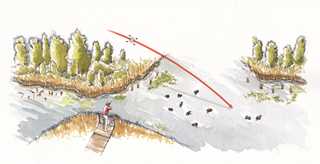
Photo Mike Sudal
Matarese recommends practicing this shot on a sporting clays station that offers low incoming targets, either straight on or from quartering angles. As you mount the gun, move the barrel to intercept the target, and don't worry about lead.
"If the target is close enough, you can shoot right at its leading edge," Matarese explains. "You don't need to perceive any space between the muzzle and the target. Keep the barrel moving to match the target's speed for a half second, then pull the trigger."
Regarding where you should intercept the target, Matarese says there is only one rule of thumb for choosing a "break point" that works every time. "Your break point is always where you see the target best, wherever it looks biggest and slowest," he says. "Distance, terrain, obstructions, and trajectory can all influence where this point is, but only your eyes can see it."
True straightaways are seldom encountered in the marsh. Flaring ducks and geese are usually also angling away from you as they fly downrange. You can practice such shots on the clays course with targets that are going away and moving slightly to either your right or left.
Unlike a hard crosser, this shot actually requires very little lead. Your movements should be short and controlled. "All you have to do is see the target and move your barrel to the break point," Matarese says. "Sometimes you have to move the gun only a few inches."
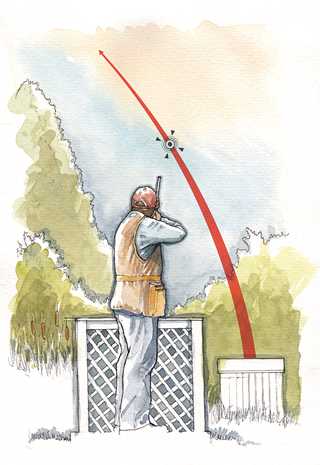
Photo Mike Sudal
Concentrate on the target and keep the shotgun moving. If you check the barrel during the shooting sequence, you're likely to shoot behind the bird. Even a going-away shot that's slightly quartering can seem to hang almost stationary in the air. The temptation is to aim at the target. Suppress this impulse and move the barrel with the target as you mount the gun. Don't worry about lead; the moving barrel will take care of that and the target will break.
If ducks or geese are unwilling to commit to the decoys, your best course of action is to take them on the pass once the birds are in range. A good time to do this is when they are flying over the blind. This can be a challenging shot for many waterfowlers because it requires the shooter to block out the bird with the end of the gun barrel. Timing is also a factor. The closer an incoming bird gets to the shooter, the faster it appears to be flying.
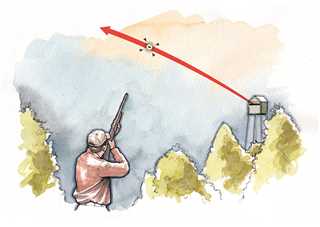
Photo Mike Sudal
"Don't wait too long," says Bill McGuire, a former sporting clays national champion and perennial All-America shooter. "You should take this shot just as quickly as you canbut stay in control. A lot of hunters want to let that bird get directly overhead. If you do that, however, you've created a 90-degree angle, and that requires more lead."
Some sporting clays courses have towers that can launch high targets over your position. Others have stations that throw rising targets over your head. Either presentation will provide the type of practice you need to perfect this shot.
"Try to get on the target a little early," McGuire advises. "Insert the gun in front of the leading edge, and as the barrel merges with the target, pull ahead slightly to get the right lead. Then pull the trigger."
Whether it's wood ducks zipping through flooded timber or scaup buzzing a diver spread, crossing birds are a waterfowler's bread and butter. The key to making this shot is getting the barrel in front of the bird before pulling the trigger. Knowing this, many waterfowlers try to measure lead, but such conscious calculations usually result in a miss.
Fortunately, the crosser is one of the easiest shots to practice on the sporting clays course. Shooting a crossing target is like merging with traffic. Instead of mounting the gun right away and chasing after the target with a fast swing, practice moving the barrel to merge with the target like a car entering traffic on a busy freeway. Increase the barrel speed slightly to pull ahead of the bird, and that should be all the lead you need.
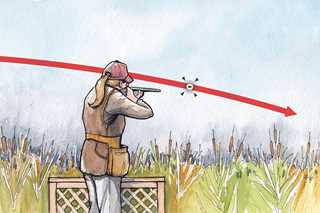
Photo Mike Sudal
"The key is connecting with the target," Matarese explains. "Time your gun mount with the speed of the bird so you merge with it as the mount is completed. On close, slow-moving targets, focus on the clay's front edge. Be sure, however, to get out in front of longer, faster targets. Once you've connected with the target, stretch your lead so that the gun is moving slightly faster than the speed of the bird, then pull the trigger."
Wild ducks rarely spring straight up into the air like the targets presented on this popular sporting clays station. Even teal, after which this station is named, launch into the sky at more acute angles. Nevertheless, this fast-moving target provides good practice for the type of flushing shots encountered when jump-shooting, or when you startle incoming birds and cause them to flare skyward.
Few sporting clays targets are as baffling or intimidating as the springing teal. Shooters often have a difficult time deciding whether to take the bird on the rise or on the fall. According to McGuire, many shooters opt to break this clay bird when it's at its peak because that's when the target is slowest. However, that's also when the target is changing direction and requires very precise timing. He recommends breaking it on the way up whenever possible. Also, instead of intersecting the target from the side, he suggests a more straight-on approach.
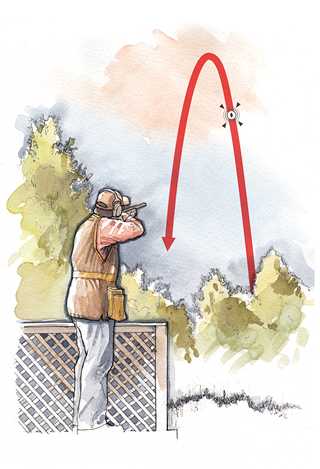
Photo Mike Sudal
"Most people set up with the gun to the right or left of the target line, so they can see the target," McGuire says. "With that method, they have to intersect its line, which requires precise timing. The more you can move in line with the target, the better your chance of hitting it."
McGuire recommends starting with your gun pointed a little more than a third of the way up from the trap. When you see the clay target, begin mounting the gun in its path. "You need to complete your mount at the point where you want to break the target," McGuire says. "When you get to where you want to pull the trigger, you should be in sync with the bird."
Ducks Unlimited uses cookies to enhance your browsing experience, optimize site functionality, analyze traffic, and deliver personalized advertising through third parties. By continuing to use this site, you agree to our use of cookies. View Privacy Policy